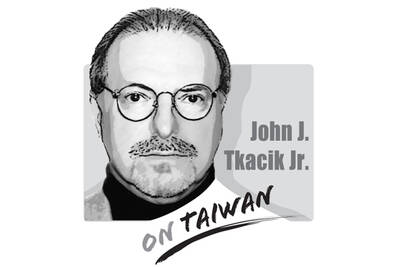Two months after the Chinese Nationalist Party (KMT) government resumed power, the Cabinet announced nine new energy-saving measures on Friday in the hope that the nation can save energy and cut greenhouse gas emissions, providing a greener environment for future generations.
The Cabinet’s announcement reflected the government’s approach to offering a clean environment with reduced emissions of carbon dioxide and other greenhouse gases. It also comes as part of the government’s effort to decrease the nation’s reliance on fossil fuels after global crude oil prices skyrocketed in recent months.
Of these measures, the Cabinet said it would like to have all the nation’s taxis running on liquefied petroleum gas (LPG) by 2012. Currently, about 16,000 to 17,000 of the nation’s 100,000 taxis are running on LPG, the government’s latest data shows.
LPG-powered vehicles offer many advantages over other types of clean-energy vehicles — such as the low cost and stable supply of fuel. Moreover, an LPG vehicle emits around 15 percent to 17 percent less carbon dioxide than a petroleum-powered vehicle.
Taiwan has been promoting the use of LPG vehicles for more than a decade. Unfortunately, support for this conversion following the Cabinet’s Friday announcement is mixed, and one of the major disputes regarding the proposal is over the number of LPG refueling stations.
While government agencies will discuss how to provide financial incentives to encourage taxi drivers to make the switch — such as a cut in excise taxes for buyers of LPG vehicles or an offer of fuel subsidies — what is important is not how high the subsidies will be, but that the number of refueling stations should be increased.
With only 23 LPG refueling stations run by state-run refiner CPC Corp, Taiwan (CPC, 台灣中油) and some by private gasoline-station operators, the Cabinet’s four-year plan to increase the total number to 150 within five years nationwide is far short of what the market will need. In comparison, there were 2,659 gasoline stations nationwide as of last month.
Moreover, an estimate made by CPC shows it normally takes up to four-and-a-half years for station operators to receive an operating license to run an LPG station.
The reason it takes so long to launch an LPG station is because many local residents have traditionally considered LPG stations to be a time bomb, and have fought against having them placed in their neighborhoods.
Even if the government imposes zoning deregulations on the launch of LPG stations, protests by residents remain a matter of concern.
Make no mistake: The plan to replace taxis that use gasoline with LPG-fueled vehicles is one with many options and can help cut fuel costs and reduce greenhouse gas emissions.
But the Cabinet must also acknowledge that the problem with taxi emissions is not just about the type of fuel they use, but also the number of empty taxis on the street.
In other words, if the government aims to target taxis as a way of cutting the nation’s energy use and cutting the nation’s carbon dioxide emissions, it needs to control the number of taxis and get empty cabs off the road.
So many empty taxis cruising the streets reflects the difficulty in helping self-employed drivers find a better job elsewhere in the labor market, a complex socioeconomic problem that the Cabinet may find more challenging to deal with over the next four years than the fuel conversion issue.

Elbridge Colby, America’s Under Secretary of Defense for Policy, is the most influential voice on defense strategy in the Second Trump Administration. For insight into his thinking, one could do no better than read his thoughts on the defense of Taiwan which he gathered in a book he wrote in 2021. The Strategy of Denial, is his contemplation of China’s rising hegemony in Asia and on how to deter China from invading Taiwan. Allowing China to absorb Taiwan, he wrote, would open the entire Indo-Pacific region to Chinese preeminence and result in a power transition that would place America’s prosperity
When Democratic Progressive Party (DPP) caucus whip Ker Chien-ming (柯建銘) first suggested a mass recall of Chinese Nationalist Party (KMT) legislators, the Taipei Times called the idea “not only absurd, but also deeply undemocratic” (“Lai’s speech and legislative chaos,” Jan. 6, page 8). In a subsequent editorial (“Recall chaos plays into KMT hands,” Jan. 9, page 8), the paper wrote that his suggestion was not a solution, and that if it failed, it would exacerbate the enmity between the parties and lead to a cascade of revenge recalls. The danger came from having the DPP orchestrate a mass recall. As it transpired,
All 24 Chinese Nationalist Party (KMT) lawmakers and suspended Hsinchu Mayor Ann Kao (高虹安), formerly of the Taiwan People’s Party (TPP), survived recall elections against them on Saturday, in a massive loss to the unprecedented mass recall movement, as well as to the ruling Democratic Progressive Party (DPP) that backed it. The outcome has surprised many, as most analysts expected that at least a few legislators would be ousted. Over the past few months, dedicated and passionate civic groups gathered more than 1 million signatures to recall KMT lawmakers, an extraordinary achievement that many believed would be enough to remove at
A few weeks ago in Kaohsiung, tech mogul turned political pundit Robert Tsao (曹興誠) joined Western Washington University professor Chen Shih-fen (陳時奮) for a public forum in support of Taiwan’s recall campaign. Kaohsiung, already the most Taiwanese independence-minded city in Taiwan, was not in need of a recall. So Chen took a different approach: He made the case that unification with China would be too expensive to work. The argument was unusual. Most of the time, we hear that Taiwan should remain free out of respect for democracy and self-determination, but cost? That is not part of the usual script, and